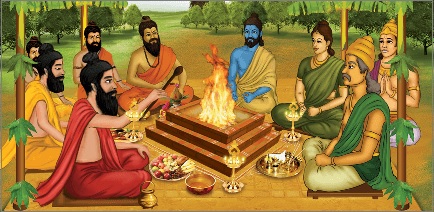Early Vedic Period
by Devender
0 1870
The period between 1500 to 1000 BC is known as the Early Vedic period. This was the period of Aryans. Aryans were the people who spoke Indo-Aryan language i.e. Sanskrit and the society was mainly male-dominated where women were treated with honor and dignity. In the early part of this period, people were mainly associated with farming and they learned to domesticate horses for riding.
Rig Veda
It is the earliest text of the Indo-European language and it contains prayers offered to Agni, Indra, Varuna & other gods and consists of mandalas (books) where 2 to 7 are the earliest called the family books while 1 and 10 being the latest editions.
The 3rd Mandal consists of the Gayatri mantra which was composed by Viswamitra to offer prayer to solar deity Savitri. It has many common things with Avesta (oldest Iranian text – Zorasterism).
Arrival of Aryans
Aryans used to call the Indus valley Sapt Sindavah which is and of 7 rivers with the river Indus (Sindhu) which are mostly mentioned in Rig Veda. Saraswati is mentioned as the holiest river in Rig Veda which was named after Harakwati (Hemland river) in south Afganistan. Aryans appeared in the subcontinent around 1500 B.C. & came into conflict with its occupants Dasas & Dasyus.
The Aryan chief that defeated Dasas & Dasyus was Trasadasyu. He was soft towards Dasas but aggressive towards Dasyus. Aryans were able to succeed everywhere because they had chariots driven by horses and better armories. They were the ones who introduced these things first time in West Asia & India. Aryans were divided into 5 tribes known as Panchajana. Among these tribes, the most powerful ones were the Bharatas of the Tritsu Family who had support from Viswamitra.
- Battle of 10 Kings
Bharat's ruling clan was opposed by 10 chiefs out of which Aryans and the rest non-Aryans which were by Vashishta. However, the Bharat clan still won the battle and joined hands with the Purus which was the most powerful among defeated tribes, and made a new tribe known as Kurus. This battle was fought at river Parushni (Ravi). Bharatvasna is named after Bharata and it is first mentioned in Rig Veda.
Early Vedic period
Agriculture was well known to pre-Aryans but their main occupation was cattle rearing and agriculture was only used to produce fodder. Most of the wars fought during this time were for the sake of cows and the term for war in Rig Veda is Gavishthi i.e. search for cows. Hence, it can be said that cows were the most important wealth of that time.
Priests were given gifts in form of cows and women and not in lands. Rig Veda also mentions some artisans namely Carpenters, Chariot makers, weavers, Leatherworkers, Potters, etc., and terms like aya which meant copper or Bronze so it shows they were familiar with the use of metals. These people mainly used the land routes and not sea ones.
- Administration in Rig Vedic period:
- The tribal chief known as Rajan was at the center
- King was known as Gopaljanya which meant protector of people and cows
- Kings had help from Purohits, Senani & Gramanis
- Kings didn't have unlimited powers
- King's position was hereditary but they could be removed only if they were found weak, and inefficient, or cruel
- Assemblies and Administrative division of Rig Vedic period:
- Societal practices and Divisions:
- Early Vedic Gods:
There were several types of assemblies such as Sabha, Samiti, Vidhata & Gana. Women were allowed in Sabha & Vidhata assemblies while Sabha & Samiti were the most important as kings and chiefs were very eager to get support in these.
Taxes and Bali (Offerings) were not made voluntarily by people. Aryans were known as Jana while Janapada or territory is not used once in Rig Veda as kingdoms or territories were not yet established.
However, Jana was divided into a group of villages which were called Vis and headed by Vrajapati. Vis was further divided into Grama or small tribal units meant for fighting headed by Graminis and Grama was further divided into Kulas headed by Kulapa.
Whenever Grama clashed with each other it was called samgrama or war and kinship was the basis of social structure where a man was known by the Kula or clan he belongs to.
Rig Veda tells about Arya varna (Aryans) & Das varna (Non-Aryans) where the distinction was probably by the color of skin. Society used to pray to gods for sons & cattle and men used to marry their brother's widow.
So, there is no mention of sati system as women's remarriage could be seen. Also, there is no mention of child marriage as the marriageable age mentioned is 16-17 years.
There were women poets too in this period which are: Apala, Vishwavara, Ghosa & Lopamudra. The society was divide into 3 groups mainly Warrior, priest & People but a 4th division was also introduced at the last stages of the period. This division was Shudra. The captured Dasas & Dasyus were treated as slaves or Shudras by Aryans mainly for domestic works.
During this time, Gods were called upon to take part in the sacrifices by the whole tribe. These sacrifices were mainly Vegetables, Barley, etc. and the Yajna (sacrifice) was performed along with chanting of Vedic hymns.

People used to pour ghee and other ingredients into the fire to get the blessings of gods. They usually used to ask for Praja (Children), Pashu (Cattle), Food, Wealth, health, etc., and eating of cows was very strictly prohibited as cows were considered very sacred animals.

Share:







Comments
Waiting for your comments